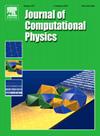Stabilized P2-DG method with artificial viscosity for steady hyperbolic conservation laws
IF 3.8
2区 物理与天体物理
Q2 COMPUTER SCIENCE, INTERDISCIPLINARY APPLICATIONS
引用次数: 0
Abstract
It is well-known that convergence to steady state is hard when a high order discontinuous Galerkin (DG) method is applied for transonic and supersonic flows in polynomial space even with post-processing such as limiters and positivity preservation. The method discretizes the hyperbolic conservation laws in space in advance to obtain a system of first-order ordinary differential equations in time. As a result, steady-state solution of the DG method is equivalent to the equilibrium point of this system. In this paper, we analyze the stability of DG methods in the view point of dynamical systems for the scalar conservation law. We show that the steady-state solution of the 3rd-order DG method is not always stable in the presence of shock waves, and then we propose an artificial viscosity to stabilize the DG method and shows that the artificial viscosity has to be order one of the mesh size to improve stability. To maintain higher order accuracy, the proposed artificial viscosity is only applied in the vicinities of shock waves together with a shock-wave indicator. Numerical results are given to verify theoretical analysis. Several transonic/supersonic flow test cases are also present to demonstrate the effectiveness of the present artificial viscosity.
求助全文
约1分钟内获得全文
求助全文
来源期刊

Journal of Computational Physics
物理-计算机:跨学科应用
CiteScore
7.60
自引率
14.60%
发文量
763
审稿时长
5.8 months
期刊介绍:
Journal of Computational Physics thoroughly treats the computational aspects of physical problems, presenting techniques for the numerical solution of mathematical equations arising in all areas of physics. The journal seeks to emphasize methods that cross disciplinary boundaries.
The Journal of Computational Physics also publishes short notes of 4 pages or less (including figures, tables, and references but excluding title pages). Letters to the Editor commenting on articles already published in this Journal will also be considered. Neither notes nor letters should have an abstract.
 求助内容:
求助内容: 应助结果提醒方式:
应助结果提醒方式:


